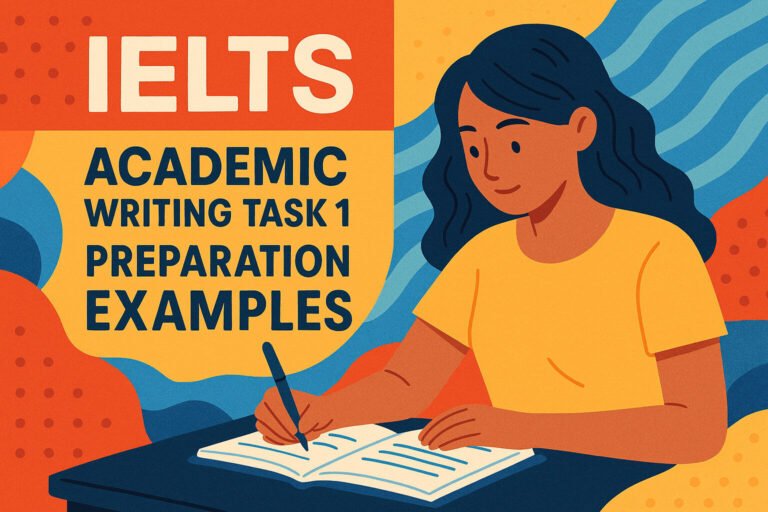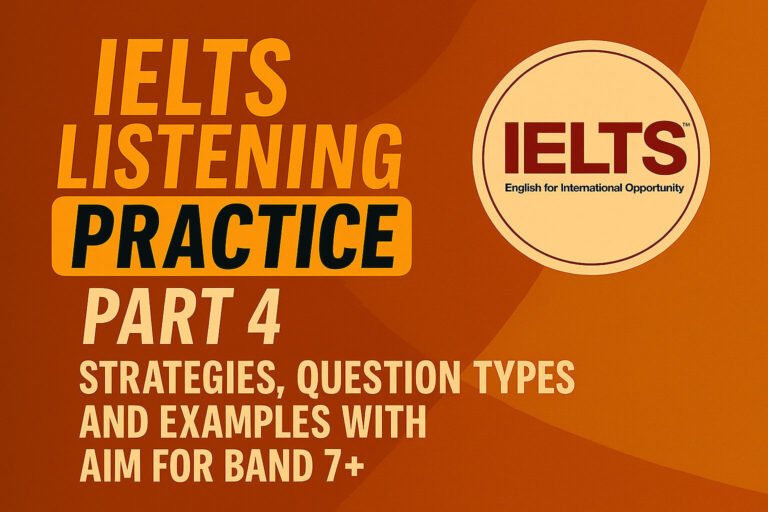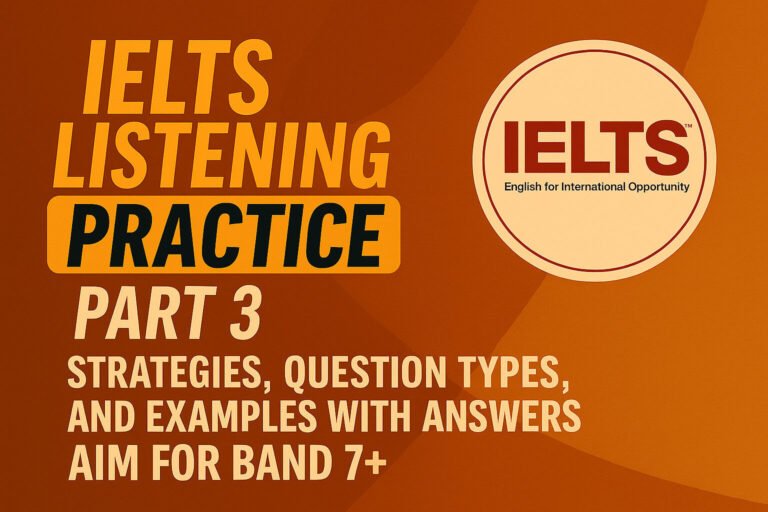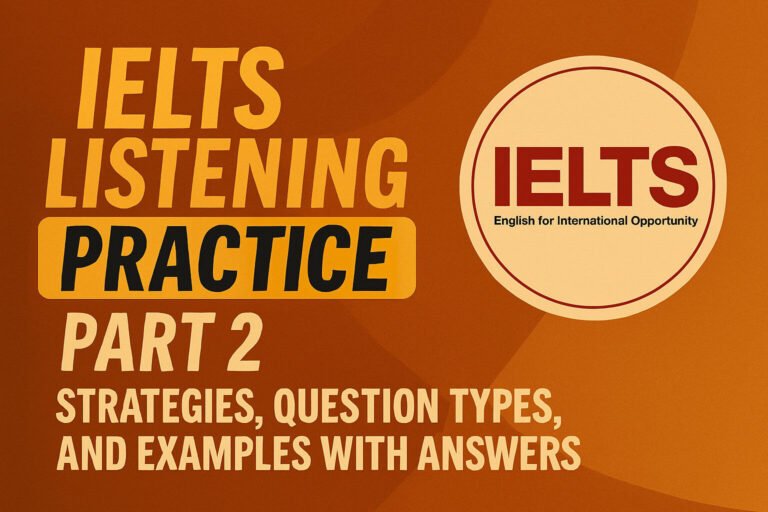IELTS listening note completion tips to skyrocket your scores. Learn essential strategies, rules, practice exercises, and common pitfalls for note completion in IELTS listening. Ideal for young aspirants eyeing study abroad success!
Hello, Ambitious IELTS taker! Ever found yourself scrambling during the listening test, missing key words in those note gaps because the speaker zipped right past? You’re in good company—over 70% of candidates struggle with note completion, often dropping precious band points. But imagine turning that around: confidently filling in blanks, nailing synonyms, and boosting your score to 7+ for that dream university abroad. This ultimate guide on IELTS listening note completion tips delivers just that—packed with strategies, real examples, and actionable steps to make you a pro. Let’s dive in and make note completion your superpower!
What Is Note Completion in IELTS Listening?
Note completion is a staple in the IELTS Listening section, where you fill gaps in notes based on an audio recording. These notes mimic real-life summaries, like lecture points or tour details, testing your ability to catch specific info under time pressure.
It appears across all four parts but shines in Parts 2 and 3, with monologues or discussions. Gaps usually require 1-3 words or numbers, drawn from everyday to academic topics.
Understanding this format is your first win—it’s not about perfect hearing but smart listening.
Note completion assesses targeted comprehension; master the basics to build confidence.
Key Rules for IELTS Listening Note Completion
Before tips, grasp the IELTS listening note completion rules. Always check word limits (e.g., “NO MORE THAN TWO WORDS AND/OR A NUMBER”)—exceeding means zero marks.
Answers must come directly from the audio, but often paraphrased. Spelling counts, so double-check. Write in capitals to avoid case errors.
No penalties for wrong answers, so guess if unsure. Transfer time is 10 minutes at the end—use it wisely.
Rules are non-negotiable; ignore them, and even great listening won’t save you.
Top IELTS Listening Note Completion Tips: Your Strategy Arsenal
Here come the game-changers: our IELTS listening note completion tips. I’ve expanded beyond basics with 10 practical ones, complete with steps and examples. Use these in your IELTS listening note completion practice for real results.
Tip 1: Read Instructions Thoroughly
Start strong—scan instructions for word limits and formats. Missing this? Instant mark loss.
Step-by-Step Action:
- Underline the limit (e.g., “ONE WORD ONLY”).
- Note if numbers or dates are expected.
- Practice this in every mock test.
Example: If instructions say “NO MORE THAN THREE WORDS,” don’t write “the beautiful ancient monument”—it’s “ancient monument.”
Instructions guide your answers; treat them like a roadmap.
Tip 2: Scan Notes and Predict Answers
Before audio plays, skim notes for context. Predict gap types: noun? Adjective? Number?
Step-by-Step Action:
- Read headings/subheadings for topic clues.
- Guess content—e.g., a gap after “founded in” might be a year.
- Jot predictions lightly.
Example: In notes on a national park, predict “wildlife species” for a gap like “home to over 200 ___.”
This sharpens focus during listening.
Prediction turns passive hearing into active hunting.
Tip 3: Focus on Keywords and Signposts
Keywords in notes signal upcoming answers. Listen for signposts like “firstly” or “however.”
Step-by-Step Action:
- Underline keywords around gaps.
- Tune in for transitions in audio.
- Note synonyms—audio might say “initiated” instead of “started.”
Example: Notes say “project began in ___”; audio: “The initiative kicked off in 2015.”
Keywords are beacons; follow them to fill gaps accurately.
Tip 4: Master Synonyms and Paraphrasing
IELTS listening note completion loves tricks—words won’t match exactly. Build synonym vocab.
Step-by-Step Action:
- Learn common pairs: “costly” = “expensive.”
- Practice rewriting notes with synonyms.
- In audio, link paraphrases quickly.
Example: Notes: “benefits include ___ health”; audio: “advantages such as improved well-being.”
Synonyms are the test’s curveball; vocabulary drills hit them out.
Tip 5: Follow Answer Order Strictly
Answers flow in sequence with the audio—no jumping around.
Step-by-Step Action:
- Number gaps clearly.
- If you miss one, move on—don’t lose the thread.
- Review order during transfer time.
Example: Gap 1 on history, then 2 on location—audio mirrors this.
Order keeps you synced; stray, and you’re lost.
Tip 6: Handle Problematic Vocabulary
Watch for tricky areas: numbers, dates, spellings, addresses.
Step-by-Step Action:
- Practice numerals—e.g., “fifteen” vs. “50.”
- Use abbreviations like “approx.” if allowed.
- Spell-check in practice.
Example: Audio: “One thousand nine hundred and ninety-nine”; write “1999.”
Tricky vocab trips many; targeted practice smooths it.
Tip 7: Beware of Distractors
Speakers often correct themselves or give false info first.
Step-by-Step Action:
- Listen for corrections like “no, actually.”
- Don’t write too soon—wait for confirmation.
- Review in mocks for distractor patterns.
Example: “It costs 10 dollars… wait, that’s for kids; adults pay 15.”
Distractors test patience; stay alert for the real answer.
Tip 8: Use Abbreviations and Shorthand
Speed up note-taking with shortcuts.
Step-by-Step Action:
- Develop personal shorthand: “+” for “and,” “>” for “more than.”
- Practice in IELTS listening note completion exercises.
- Expand during transfer.
Example: “International students” becomes “intl stdnts.”
Shorthand saves seconds; those add up.
Tip 9: Guess Intelligently If Stuck
Never leave blanks—educated guesses score sometimes.
Step-by-Step Action:
- Use context from notes.
- Fill based on predictions.
- Prioritize not missing the next.
Example: Unsure on “famous for ___ cuisine”? Guess “Italian” if topic fits.
Guessing beats blank; it’s low-risk.
Tip 10: Review and Transfer Smartly
Use the 10-minute transfer to polish.
Step-by-Step Action:
- Check spelling and limits.
- Ensure legibility.
- Fix any missed gaps.
Transfer time is your safety net; use it fully.
Common Mistakes in IELTS Listening Note Completion and How to Avoid Them
Avoid pitfalls that tank scores. Common ones: Ignoring limits, poor spelling, panicking over accents.
Checklist to Dodge Mistakes:
- Word Limit Overruns: Stick strictly—practice counting words.
- Spelling Errors: Build vocab lists; use phonetics.
- Missing Synonyms: Daily synonym exercises.
- Losing Place: Mark audio progress with ticks.
Example: Writing “childrens” instead of “children’s”—costs a mark.
Mini Takeaway: Mistakes are learnable; analyze them to improve.
IELTS Listening Note Completion Practice: Drills and Exercises
Theory alone won’t cut it—dive into IELTS listening note completion practice test routines.
Start with official samples, then timed mocks. Focus on diverse accents: British, Australian, American.
Numbered Practice Plan:
- Warm-up: Listen without notes, summarize orally.
- Drill: Complete 5 gaps per day from past papers.
- Full Test: Weekly simulation, score, and review.
- Advanced: Create your own notes from podcasts.
For IELTS listening note completion exercises, try themes like environment or education.
Practice builds muscle memory; consistency is key.
FAQ: Quick Answers to Your IELTS Listening Note Completion Queries
Tailored for Google’s People Also Ask:
What are the rules for IELTS listening note completion? Follow word limits strictly, use exact or paraphrased audio words, and spell correctly. IELTS listening note completion rules ensure fair marking—always check instructions.
How can I practice IELTS listening note completion effectively? Use official tests and timed exercises. Incorporate IELTS listening note completion practice daily, focusing on synonyms and distractors for quick gains.
What is note completion in IELTS listening? It’s filling gaps in notes from audio, testing specific detail capture. Note completion IELTS listening often uses summaries or outlines.
Are there exercises for IELTS listening note completion? Yes! Try IELTS listening note completion exercises from Cambridge books or online sites for varied topics and difficulty.
How to handle synonyms in IELTS listening note completion? Build vocab lists and practice paraphrasing. In IELTS listening note completion practice test, listen for word variations to match gaps.
What’s the best tip for IELTS listening note completion? Predict answers pre-audio—it’s a top IELTS listening note completion tips strategy to stay ahead.
Final Thoughts: Conquer IELTS Listening Note Completion Today
You’ve armed yourself with powerhouse IELTS listening note completion tips, from prediction to distractor dodging, plus rules, practice drills, and mistake fixes. Implementing these will transform your listening game, paving the way for that high band score and study abroad adventure. Remember, every practice session brings you closer—stay motivated, young achiever!
For more, explore our IELTS Speaking Cue Card Strategies post. Grab authentic materials from the Official Cambridge IELTS site.











